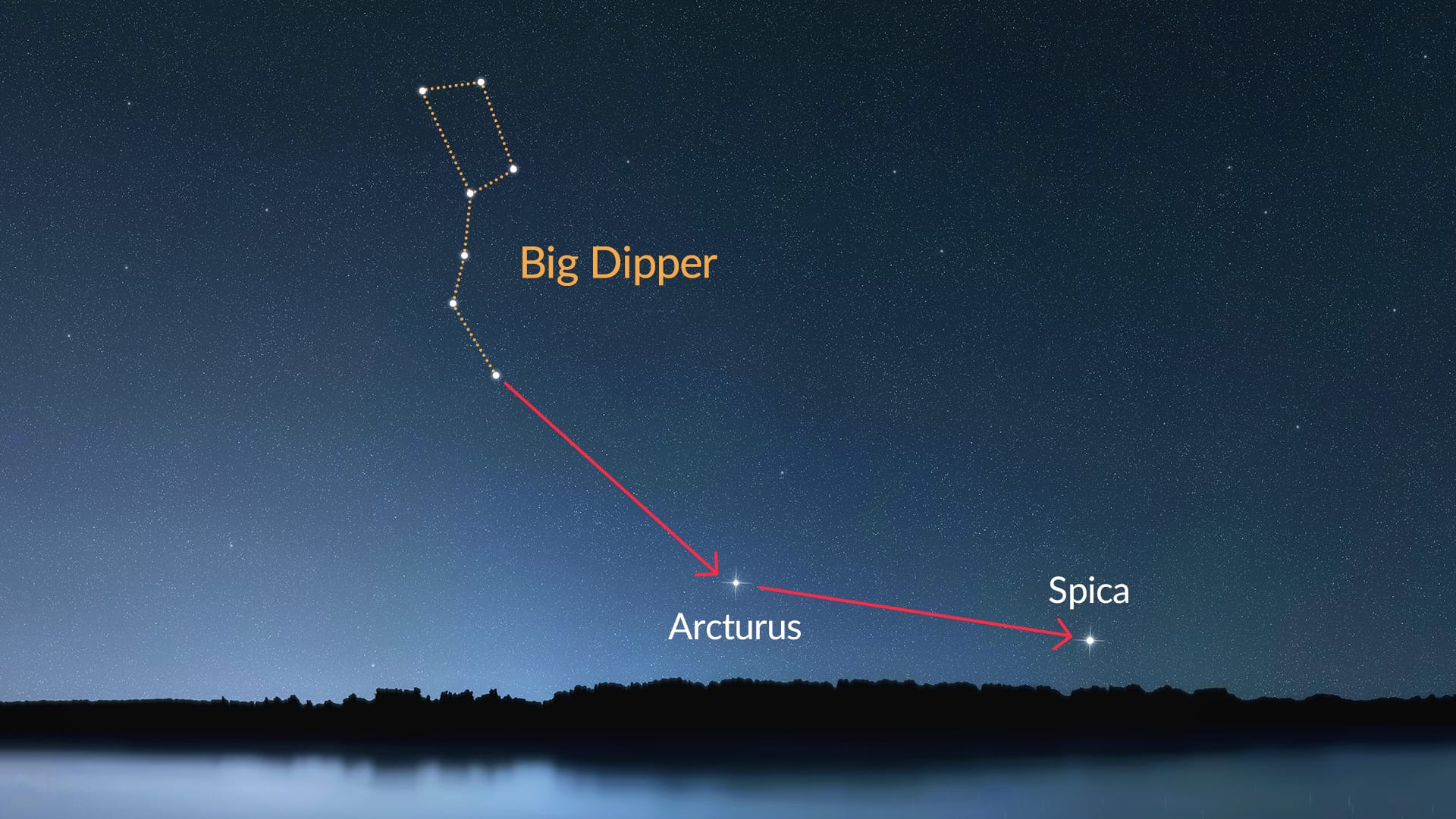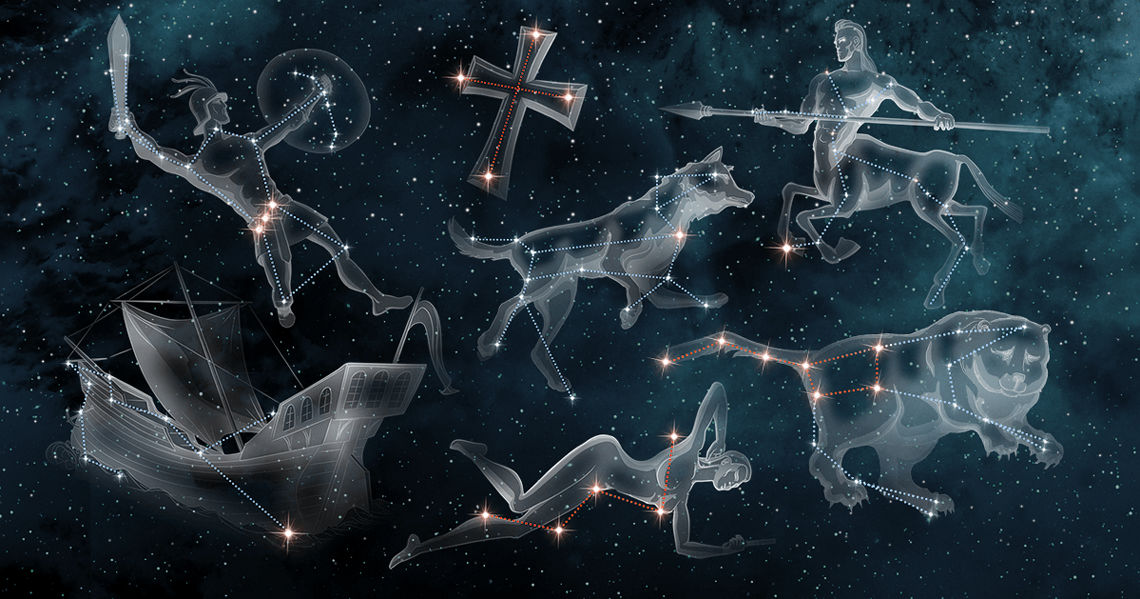Spica (Alpha Virginis): Brightest Star In Virgo
Say hello to Spica, the bright bluish Alpha star of Virgo! This stunning star often appears close to the Moon and planets in the sky. Want to make sure you’ll see it? Let the Star Walk 2 app guide you right to it. Discover more about Spica and its upcoming celestial events.
Contents
- Spica star facts: what is Spica?
- Spica constellation: how to find Spica?
- When to see Spica
- Virgo’s brightest star Spica is, in fact, 2 stars
- More facts about Spica
- What is Spica: bottom line
Spica star facts: what is Spica?
- Official names: Spica, Alpha Virginis, α Vir
- Alternative names: Azimech, Spica Virginis
- Catalog designations: 67 Virginis, HD 116658, HIP 65474, HR 5056
- Constellation: Virgo
- Star type: binary star system
- Right ascension: 13h 25m 11.58s
- Declination: −11° 09′ 40.8″
- Apparent magnitude: 1.0
- Mass: 11.43 solar masses
- Luminosity: 20,512 L
- Radius: 7.47 solar radius
- Surface temperature: 20,900 K
- Distance from the Earth: 250 light-years
- Rotation period: 4 days
Spica constellation: how to find Spica?
The blue-white star Spica in the constellation Virgo is bright enough (mag 1.0) to be seen with the naked eye. Here's what can help you find Spica’s location.
Use the Big Dipper

One way to locate Spica is by using the Big Dipper – one of the most recognizable star patterns in the sky. Extend the curve of the Big Dipper's handle to find Arcturus, and then continue the line roughly as far again to reach Spica. There’s a mnemonic rule to remember this technique: “Arc to Arcturus and spike to Spica”.

Use a star finder app

Another convenient way to find Spica is by using a stargazing app like Sky Tonight. It provides real-time information about celestial objects and their locations. With this free app, you can find Spica in a few simple steps:
- Open the app’s search bar and type “Spica.”
- Tap the blue target button to the right of the matching result. The app will show you the star's position on the sky map.
- Tap the blue compass button at the bottom right of the screen. The app will use your device’s location to align the screen image with the real sky above you.
- Follow the white arrow until you see Spica on the screen and in the real sky.
When to see Spica
As a part of a zodiac constellation, Spica can be seen in the sky during certain months. The best time to observe the star is from March to late June. Keep in mind that from mid-September to the end of October, the Sun visits Virgo, so Spica is in the sky during the daytime.
Observe Spica next to the Moon
Spica is one of the four brightest stars that sit very close to the ecliptic – the Sun’s yearly path across the sky (the other three are Antares, Regulus, and Aldebaran). Because Spica lies so close to this path, the Moon and planets often pass near it. Let’s take a look at the upcoming events featuring Spica.
December 14, 2025: Moon and Spica
- Close approach time: 16:17 GMT
- Close approach distance: 1°43'
- Conjunction time: 17:07 GMT
- Conjunction distance: 1°49'
On December 14, bluish Spica (mag 0.97) will meet the waning crescent Moon (28% illuminated). The objects will appear low in the east-southeastern sky late at night. They will be visible to the naked eye in the constellation Virgo.
You can often see bright dots near the Moon. Apart from Spica, these could be other bright objects, such as Venus or Jupiter. To stay updated on when the Moon meets the planets, read our dedicated article.
You can also check the “Events” tab in the Sky Tonight’s calendar from time to time: there, you can find a lot of useful information about everything that happens in the night sky (watch our video and see for yourself).
January 10, 2026: Moon and Spica
- Close approach time: 21:12 GMT
- Close approach distance: 1°45'
- Conjunction time: 23:18 GMT
- Conjunction distance: 2°05'
On January 10, Spica (mag 1.0) will appear next to the Last Quarter Moon. The pair will rise around or after midnight, depending on your location. They will be easy to spot with the naked eye. You can also use binoculars to examine the Moon’s maria and craters – the quarter phase is one of the best times to observe the Moon through optics.
February 7, 2026: Moon and Spica
- Close approach time: 08:49 GMT
- Close approach distance: 2°26'
- Conjunction time: 10:15 GMT
- Conjunction distance: 2°33'
On February 7, Spica (mag 1.0) will appear next to the waning gibbous Moon (73% illuminated). The pair will rise low in the east–southeast sky around midnight, depending on your location. The Moon and Spica can be seen with the naked eye. However, the bright Moon may make Spica harder to spot, so use binoculars for a clearer view of the bluish star beside the Moon.
Virgo’s brightest star Spica is, in fact, 2 stars
Spica is not an individual star: it is a binary star system, that consists of two stars known as Spica A and Spica B. These stars orbit each other so close that they can’t even be resolved as two stars through a telescope. Also, their mutual gravity distorts them into an oval shape.
Spica A
Spica A is the larger and more massive star of the pair. It is a blue-white giant star that shines with a luminosity over 2,000 times that of our Sun: 80% of the light in the star system comes from Spica A. With a diameter approximately 10 times larger than the Sun, Spica A is an impressive celestial body.

Spica B
Spica B is a smaller and less massive component of the star system. It is a blue-white main-sequence star, meaning it is still in the process of burning hydrogen in its core. Although smaller than Spica A, Spica B is still seven times larger than our Sun.
More facts about Spica
Brightest star in Virgo
Spica is the brightest star in the constellation Virgo. Also, it is ranked as the 15th brightest star overall (or 16th, if you count the Sun).

Ear of grain in Virgo’s hand
The name “Spica” comes from the Latin word for “ear of grain”, as it represents a single stalk of wheat held by Demeter – the goddess of agriculture in Greek mythology, which was associated with the constellation Virgo.
Guiding star
Spica is listed among 57 navigational stars. Due to its brightness and proximity to the ecliptic, Spica is often used as a navigational reference point for spacecraft and satellites.
Part of the Spring Triangle and the Great Diamond
Spica is part of the two asterisms: the Spring Triangle (along with Arcturus in the constellation Bootes and Regulus in the constellation Leo), and the Great Diamond (along with Arcturus in the constellation Bootes, Denebola in the constellation Leo, and Cor Caroli in Canes Venatici).
Lunar occultations of Spica come in cycles
Spica lies about 2° south of the ecliptic. Meanwhile, the Moon wanders about 5° north to 5° south of the ecliptic, returning to the same position every 18.6 years. That geometry creates long periods when the Moon passes just above or below Spica, followed by several months when it regularly passes in front of it, creating a cycle of lunar occultations*.
The last occultation cycle spanned from June 16, 2024, to November 17, 2025. And now, the Moon passes south of Spica each month. The next series of about 20 occultations (including partial and grazing occultations) will occur between February 12, 2031, and July 15, 2032. After that, the Moon will move north of Spica for several years before meeting the star again on January 4, 2043.
*A lunar occultation is when the Moon passes in front of a more distant celestial object, like a star or planet, and temporarily hides it from view in some regions of the Earth.
What is Spica: bottom line
Spica is the brightest star in the constellation Virgo. The star often passes close to the Moon and planets – the next events are listed in the "When to see Spica" section of this article. You can locate Spica by using the Big Dipper or stargazing apps, like Sky Tonight and Star Walk 2.
